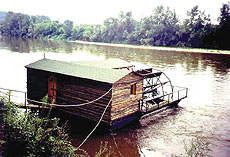 |
| The Ibar rises in Mokra Planina mountain. Its waters reach the Danube via the Zapadna Morava and the Velika Morava rivers |
Phenol concentrations were found to be on certain days several hundred times higher than normal, which made it very difficult to provide with drinking water about 100,000 inhabitants of the town of Kraljevo and its surroundings. Wildlife was also threatened.
A town battles for its water
The battle against pollution that affected the town´s water supply system
lasted several weeks and its population was forced to use water from cisterns
or buy bottled drinking water. The Red Cross teams as well as local and international
NGOs rushed to help Kraljevo, while the public and the media demanded that the
culprits, those who were "killing” the river, be named and prosecuted.
They also demanded that a long-term solution be found to ensure high quality drinking
water in the area.
It was easy to determine that the massive pollution, reported following some heavy
rains, originated in the Kosovo Province, specifically from the Obilic-based chemical
and energy plants, and reached Kraljevo via the Sitnica River. Interestingly,
the responsible state institutions in Serbia were neither informed nor warned
about the threat of phenol leaking into the river. Similar accidents have happened
in the past 20 years.
Older inhabitants of Kraljevo talk emotionally about 1950s when Ibar used to be
a real beauty, boasting crystal-clear water, safe even for drinking. But as years
passed by, the river was gradually turned into a wastewater canal – a casualty
of the manufacturing and mining development in the Kosovo and Metohija Province
that brought to the river unacceptable concentrations of phenol and heavy metals.
Pollution of the Ibar affects a much wider area, reaching – through the Zapadna
Morava and the Velika Morava rivers – as far as the Danube Basin.
Serbian government acts
 |
Spurred by the obviously inefficient control excercised by the responsible
authorities in Kosovo and by the fact that they failed to inform the responsible
institutions in the Republic of Serbia, the Serbian government in the beginning
of 2003 filed a protest with the head of UNMIK administration in Kosovo. At the
same time, the Serbian Ministry of the Environment informed UNEP – both in
Geneva and in Nairobi – about the accident and asked for help. In cooperation
with UNMIK, a Serbian expert team inspected the former coal gasification plant
based in Obilic, Kosovo, and found out that although the plant had been closed
since 1988, raw phenol reservoirs remained, as well as phenol water and phenol
waste waters, which leaked into the surface waters after heavy rains or floods
and reached the Sitnica and the Ibar rivers. This happened because of a lack of
adequate protection and installations. It is estimated that reservoirs in Obilic
still contain about 800 tonnes of raw phenol and about 10,000 tonnes of phenol
water, thus representing a permanent environmental threat to the surrounding area.
UNMIK expert teams also detected extremely high phenol concentrations in the Sitnica
(measured January 24, 2003) and the Ibar (measured January 25, 2003) rivers -
880 and 490 micrograms per liter respectively against the upper limit of one microgram
per liter under the present regulations of Serbia-Montenegro.
International organisations respond
 |
A joint UNEP / OCHA expert team was also formed to evaluate the situation on the spot and monitor the work of Serbian and Kosovo authorities. The UN experts warned that several wells in Kraljevo were polluted to the extent that they should no longer be used. Thanks to the public pressure, and after detailed information on the damaging effects of phenol on human health were made public, the Serbian government supported – as an urgent measure – a project for a long-term water supply of the town of Kraljevo from the Lopatnica River. A reservoir lake and a water processing plant are to be built as well, thus ensuring that Kraljevo and several other towns in central Serbia are supplied with high quality drinking water.
Project for a safe future
The first phase of the EUR70m project is already under way. The project is
partly financed by the Serbian government. The Serbian Ministry of the Environment
supports the idea of an early-warning system for pollution compatible with the
ICPDR system and based on the APELL programme developed by UNEP.
The final UNEP analysis of phenol pollution in the Ibar is due to be completed
soon and so is a common management system of the Sitnica-Ibar river basin. It
is of utmost importance that – through cooperation between the responsible
Serbian and Kosovo institutions - solutions be found to prevent similar ecological
accidents in the future and protect natural resources in one of the most densely
populated areas in the Balkans. It is a way to – in the words of the local
population - stop killing the Ibar River and bring it back to life.